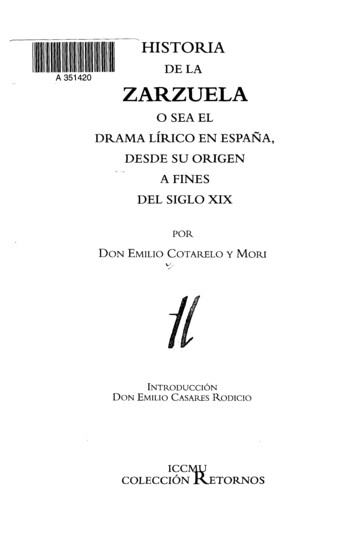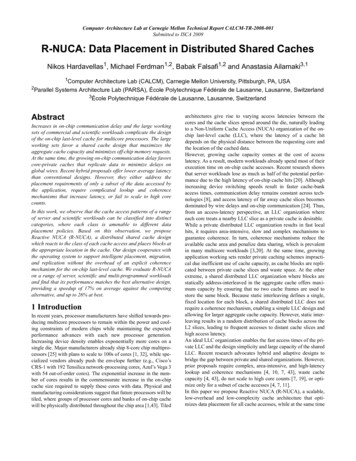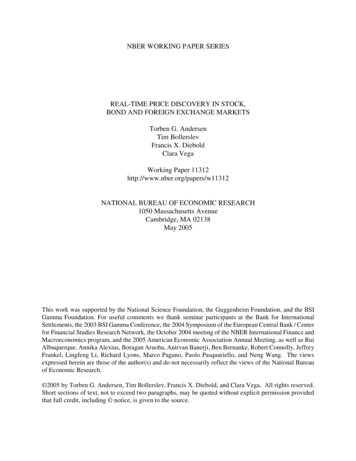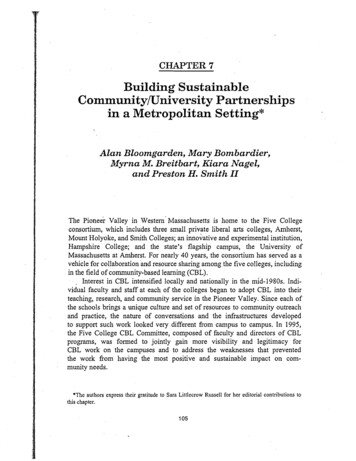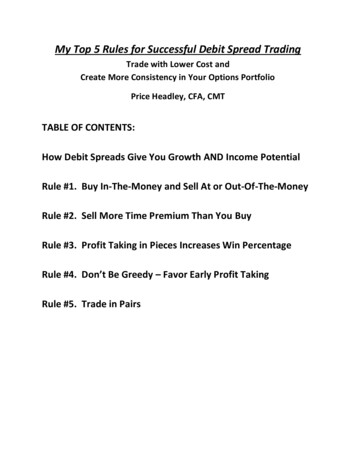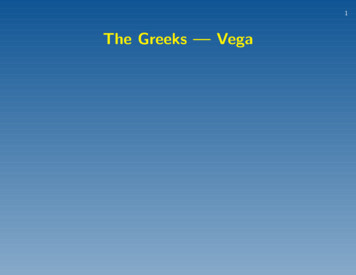
Transcription
1The Greeks — Vega
1The Greeks — VegaOutline: Explanation of the greeks. Using greeks for short term prediction. How to find vega. Factors influencing vega.
2Outline continued: Using greeks to shield your portfolio Vega neutral Making both delta and vega neutral Volatility over time.
3What are the GreeksWhat are the greeks and why be concerned with them?Two reasons: the direction in which an option trade is about to head ispredicted by the greeks (given a change in the market); greeks show how to protect your position against adversemovements in critical market variables.
4Black–Scholes Price FactorsThe price C of an option (or combination of options)depends on:BS FactorCorresponding GreekMathematicallyStime to expiry, Tvolatility, σrisk-free rate, rstrike price, X theta Θvega νrho ρ C/ S C/ T C/ σ C/ rshare price,deltano greek, xedThis table pairs up each primary greek with the factor itcontrols. As you can see, delta relates to the price of the
5underlying, vega relates to the volatility of the underlyingand so on. But what is the relationship?In fact, delta is a number that tells in what direction andto what extent the option price will move if there is apositive unit change in the stock price, in the stock priceonly.Similarly, vega is a number that tells in what directionand to what extent the option price will move if there isa positive 1% change in the volatility, and only in thevolatility.
6Vega ExampleFor example, consider a 3-month call option with strikeprice 50 on a stock currently at 50. Assume thecurrent volatility is 40%. The option costs 4.21 and itsvega is 0.10.Since vega is positive, the option price will go up if thevolatility goes up; and it will go up by 10 cents for everyone percent gain in volatility. (At least for awhile.)Conversely, the option price will retreat by 10 cents forevery one percent loss in volatility.
7In fact in this example, with the volatility at 41%, theoption price is indeed 4.31.In this same example, if volatility goes up to 50%, theoption price goes to 5.19 (not quite 1, vega is now at0.098).
8Miscellaneous Facts about VegaVega is always positive, and, moreover, is the same valuefor puts as for calls; thus option prices always increase asthe volatility does.Of course, the vega of a short position is negative.Vega for a portfolio is the sum of the vegas of itsconstituents.Vega is important to consider for straddles and calendarspreads.
9Black-Scholes Formula for Vegarν ST e2πlog(S/X) (r σ 2/2)T 2/(2σ 2T )or, in the Black-Scholes d1 notation, ν S T φ(d1), φ() is the normal density
10Factors Influencing VegaAs vega becomes smaller, volatility has less effect on theoption price. In the example, if vega were 0.05 instead of0.10, then the option price will increase only half asmuch.The size of vega itself mainly depends on the relativevalue between the stock price and the strike price and onthe time to expiry of the option. In the following figurewe show the dependence of vega on time to expiry.
11Vega changes with Time to Expiry
12Vega changes with Stock Price
13How to find VegaTo figure vega for your portfolio, find vega for all thecomponents and add them up for your long positions andsubtract for your short ones, Weight each according toits number of contracts.To find vega for each component, consult your broker’sweb page. On the next slide I show TradeKing’s.I could find no non-login web site calculating vega givenan option contract, but there are several that calculatethe greeks provided you enter all the relevantinformation. E.g. http://www.option-price.com.
14
15The Greeks as a ShieldThe most famous use of a greek to protect your positionfrom market movements is delta hedging. By makingyour portfolio delta neutral you are protected to a degreefrom modest price movements.Similarly if you want to protect yourself from modestvolatility movements you make your position veganeutral.But the vega of a stock is 0 so one cannot achieve veganeutrality by shorting stock. It is necessary to short some
16other option to achieve it.Suppose your current portfolio has a vega of ν0 and youare willing to take a negative position in anotherderivative whose per unit vega νA. Shorting w units ofthe addition makes the combined portfolio vega neutral ifν0w .νA
17Delta and Vega NeutralSuppose our original portfolio has a delta of 0 and a vegaof ν0 6 0. We add to the portfolio by shorting w units anoption with vega equal to νA. But now our new portfoliois no longer delta neutral, instead it has a delta of w Awhere A is the delta of added option (could benegative). We must therefore buy w A shares of A (sellif A is negative) to make the new portfolio both deltaand vega neutral.
18Volatility Over TimeDoes volatility really change much from day to day?
19From year to year?
20Can VIX (volatility trends) foretell of pending trouble?
4 Black–Scholes Price Factors The price C of an option (or combination of options) depends on: BS Factor Corresponding Greek Mathematically share price, S delta C/ S volatility, σ vega ν C/ σ risk-free rate, r rho ρ C/ r strike price, X no greek, xed This table pairs up each primary greek with the factor it
